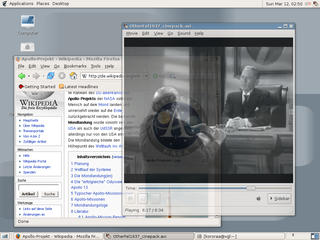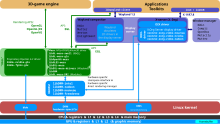
The X Window System is a windowing system for bitmap displays, common on Unix-like operating systems.

In computing, a windowing system is a software suite that manages separately different parts of display screens. It is a type of graphical user interface (GUI) which implements the WIMP paradigm for a user interface.
In computing, on the X Window System, X11 color names are represented in a simple text file, which maps certain strings to RGB color values. It was traditionally shipped with every X11 installation, hence the name, and is usually located in <X11root>/lib/X11/rgb.txt. The web colors list is descended from it but differs for certain color names.
freedesktop.org (fd.o), formerly X Desktop Group (XDG), is a project to work on interoperability and shared base technology for free-software desktop environments for the X Window System (X11) and Wayland on Linux and other Unix-like operating systems. Although freedesktop.org produces specifications for interoperability, it is not a formal standards body.

The X.Org Foundation is a non-profit corporation chartered to research, develop, support, organize, administrate, standardize, promote, and defend a free and open accelerated graphics stack. This includes, but is not limited to, the following projects: DRM, Mesa 3D, Wayland, and the X Window System and its primary implementation, the X.Org Server.
X.Org Server is the free and open-source implementation of the X Window System (X11) display server stewarded by the X.Org Foundation.
In computing, the X Window System is a network-transparent windowing system for bitmap displays. This article details the protocols and technical structure of X11.

X Toolkit Intrinsics is a library that implements an API to facilitate the development of programs with a graphical user interface (GUI) for the X Window System. It can be used in the C language. Design took place late 1980s to early 1990s.

Xgl is an obsolete display server implementation supporting the X Window System protocol designed to take advantage of modern graphics cards via their OpenGL drivers, layered on top of OpenGL. It supports hardware acceleration of all X, OpenGL and XVideo applications and graphical effects by a compositing window manager such as Compiz or Beryl. The project was started by David Reveman of Novell and first released on January 2, 2006. It was removed from the X.org server in favor of AIGLX on June 12, 2008.

Xlib is an X Window System protocol client library written in the C programming language. It contains functions for interacting with an X server. These functions allow programmers to write programs without knowing the details of the X protocol.
In computing, XFixes is an X Window System extension which makes useful additions to the X11 protocol. It was started in 2003 by Keith Packard. It first appeared in the KDrive X server and later in X.Org Server version 6.8.0.

The X Rendering Extension is an extension to the X11 core protocol to implement image compositing in the X server, to allow an efficient display of transparent images.

Selections, cut buffers, and drag-and-drop are the mechanisms used in the X Window System to allow a user to transfer data from one window to another. Selections and cut buffer are typically used when a user selects text or some other data in a window and pastes in another one. Drag-and-drop is used when a user selects something in a window, then clicks on the selection and drags it into another window.
The X Window System core protocol is the base protocol of the X Window System, which is a networked windowing system for bitmap displays used to build graphical user interfaces on Unix, Unix-like, and other operating systems. The X Window System is based on a client–server model: a single server controls the input/output hardware, such as the screen, the keyboard, and the mouse; all application programs act as clients, interacting with the user and with the other clients via the server. This interaction is regulated by the X Window System core protocol. Other protocols related to the X Window System exist, both built at the top of the X Window System core protocol or as separate protocols.
In human–computer interfaces, the X keyboard extension or XKB is a part of the X Window System that extends the ability to control the keyboard over what is offered by the X Window System core protocol, and allows to use multiple keyboard layouts.
The MIT Shared Memory Extension or MIT-SHM or XShm is an X Window System extension for exchange of image data between client and server using shared memory. The mechanism only works when both pieces are on the same computer.

Xephyr is display server software implementing the X11 display server protocol based on KDrive which targets a window on a host X Server as its framebuffer. It is written by Matthew Allum. Xephyr is an X-on-X implementation and runs on X.Org Server and can work with Glamor. Future versions could make use of libinput. Replacing Xephyr with the xf86-video-dummy and xf86-video-nested drivers in the normal X.Org server is being considered as part of X11R7.8.

Wayland is a communication protocol that specifies the communication between a display server and its clients, as well as a C library implementation of that protocol. A display server using the Wayland protocol is called a Wayland compositor, because it additionally performs the task of a compositing window manager.

awesome is a dynamic window manager for the X Window System developed in the C and Lua programming languages. Lua is also used for configuring and extending the window manager. Its development began as a fork of dwm, though has differed considerably since. It aims to be extremely small and fast, yet extensively customizable. It makes it possible for the user to manage windows with the use of keyboard.

















